 Ku Klux Klan rally, 1923. | |
| In existence | |
|---|---|
| 1st Klan | 1865–1870s |
| 2nd Klan | 1915–1944 |
| 3rd Klan1 | since 1946 |
| Members | |
| 1st Klan | 550,000 |
| 2nd Klan | between 3 and 6 million[1] (peaked in 1920–1925 period) |
| Properties | |
| Origin | United States of America |
| Political ideology | White supremacy White nationalism Nativism |
| Political position | Far-right |
| Religion | Protestant Christianity |
| 1The 3rd Klan is decentralized, with approx. 179 chapters. | |
Ku Klux Klan, often abbreviated KKK and informally known as The Klan, is the name of three distinct past and present far-right[2][3][4][5] organizations in the United States, which have advocated extremist reactionary currents such as white supremacy, white nationalism, and anti-immigration, historically expressed through terrorism.[6] Since the mid-20th century, the KKK has also been anti-communist.[6] The current manifestation is splintered into several chapters and is classified as a hate group.[7]
The first Klan flourished in the South in the 1860s, then died out by the early 1870s. Their iconic white costumes consisted of robes, masks, and conical hats, and were designed to be outlandish and terrifying.[8] The second KKK flourished nationwide in the early and mid 1920s, and adopted the same costumes and code words as the first Klan, while introducing cross burnings. The third KKK emerged after World War II and was associated with opposing the civil rights movement and progress among minorities. All incarnations of the Klan have well-established records of engaging in terrorism, though historians debate how widely the tactic was supported by the membership of the second KKK.
Three Klans
First KKK
The first Klan was founded in 1865 in Pulaski, Tennessee by veterans of the Confederate Army. Although it never had an organizational structure above the local level, similar groups across the South adopted the name and methods. Klan groups spread throughout the South as an insurgent movement during the Reconstruction era in the United States As a secret vigilante group, the Klan focused its anger reacted against Radical Republicans and sought to restore white supremacy by threats and violence, including murder, against black and white Republicans. In 1870 and 1871 the federal government passed the Force Acts, which were used to prosecute Klan crimes. Prosecution of Klan crimes and enforcement of the Force Acts suppressed Klan activity. In 1874 and later, however, newly organized and openly active paramilitary organizations, such as the White League and the Red Shirts, started a fresh round of violence aimed at suppressing Republican voting and running Republicans out of office. These contributed to segregationist white Democrats regaining political power in all the Southern states by 1877.
Second KKK
In 1915, the second Klan was founded and remained a small organization in Georgia. Starting in 1921 it adopted a modern business system of recruiting (which paid most of the initiation fee and costume charges to the organizers) and grew rapidly nationwide at a time of prosperity. The second KKK preached Americanism and purification of politics, with a heavy tome of racism, anti-Catholicism, anti-Communism, nativism, and antisemitism. Some local groups took part in attacks on private houses, and carried out other violent activities. The violent episodes were generally in the South.[9]
The second Klan was a formal fraternal organization, with a national and state structure. At its peak in the mid-1920s, the organization claimed to include about 15% of the nation's eligible population, approximately 4–5 million men. Internal divisions, criminal behavior by leaders, and external opposition brought about a collapse in membership, which had dropped to about 30,000 by 1930. It finally faded away in the 1940s.[10]
Third KKK
The "Ku Klux Klan" name was used by many independent local groups opposing the Civil Rights Movement and desegregation, especially in the 1950s and 1960s. During this period, they often forged alliances with Southern police departments, as in Birmingham, Alabama; or with governor's offices, as with George Wallace of Alabama.[11] Several members of KKK groups were convicted of murder in the deaths of civil rights workers and children in the bombing of the 16th Street Baptist Church in Birmingham. Today, researchers estimate that there may be approximately 150 Klan chapters with upwards of 5,000 members nationwide.[12]
Today, a large majority of sources consider the Klan to be a "subversive or terrorist organization".[12][13][14][15] In 1999, the city council of Charleston, South Carolina passed a resolution declaring the Klan to be a terrorist organization.[16] A similar effort was made in 2004 when a professor at the University of Louisville began a campaign to have the Klan declared a terrorist organization so it could be banned from campus.[17] In April 1997, FBI agents arrested four members of the True Knights of the Ku Klux Klan in Dallas for conspiracy to commit robbery and to blow up a natural gas processing plant.[18]
First Klan 1865–1874
Creation and naming

Six well-educated Confederate veterans from Pulaski, Tennessee, created the original Ku Klux Klan on December 24, 1865, during Reconstruction of the South after the Civil War.[19] The name was formed by combining the Greek kyklos (κυκλος, circle) with clan.[20] The group was known for a short time as the "Kuklux Clan." The Ku Klux Klan was one among a number of secret, oath-bound organizations using violence, including the Southern Cross in New Orleans (1865), and the Knights of the White Camellia (1867) in Louisiana.[21]
Historians generally see the KKK as part of the postwar insurgent violence related not only to the high number of veterans in the population, but also to their effort to control the dramatically changed social situation by using extrajudicial means to restore white supremacy. In 1866, Mississippi Governor William L. Sharkey reported that disorder, lack of control and lawlessness were widespread; in some states armed bands of Confederate soldiers roamed at will. The Klan used public violence against blacks as intimidation. They burned houses, and attacked and killed blacks, leaving their bodies on the roads.[22]
In an 1867 meeting in Nashville, Tennessee, Klan members gathered to try to create a hierarchical organization with local chapters eventually reporting up to a national headquarters. They elected Brian A. Scates to be the Leader and President of this organization. Since most of the Klan's members were veterans, they were used to the hierarchical structure of the organization, but the Klan never operated under this centralized structure. Local chapters and bands were highly independent.
Former Confederate Brigadier General George Gordon developed the Prescript, or Klan dogma. The Prescript suggested elements of white supremacist belief. For instance, an applicant should be asked if he was in favor of "a white man's government", "the reenfranchisement and emancipation of the white men of the South, and the restitution of the Southern people to all their rights."[23] The latter is a reference to the Ironclad Oath, which stripped the vote from white persons who refused to swear that they had not borne arms against the Union. In practice only a minority of white men were disfranchised.
Gordon was said to have told former slave trader and Confederate General Nathan Bedford Forrest about the Klan. Forrest allegedly responded, "That's a good thing; that's a damn good thing. We can use that to keep the niggers in their place."[24] Possibly Forrest went on to become Grand Wizard, the Klan's national leader.[25][26]
In an 1868 newspaper interview, Forrest stated that the Klan's primary opposition was to the Loyal Leagues, Republican state governments, people like Tennessee governor Brownlow and other carpetbaggers and scalawags. He argued that many southerners believed that blacks were voting for the Republican Party because they were being hoodwinked by the Loyal Leagues.[27] One Alabama newspaper editor declared "The League is nothing more than a nigger Ku Klux Klan."[28]
Despite Gordon's and Forrest's work, local Klan units never accepted the Prescript and continued to operate autonomously. There were never hierarchical levels or state headquarters. Klan members used violence to settle old feuds and local grudges, as they worked to restore white dominance in the disrupted postwar society. The historian Elaine Frantz Parsons describes the membership:
Lifting the Klan mask revealed a chaotic multitude of antiblack vigilante groups, disgruntled poor white farmers, wartime guerrilla bands, displaced Democratic politicians, illegal whiskey distillers, coercive moral reformers, sadists, rapists, white workmen fearful of black competition, employers trying to enforce labor discipline, common thieves, neighbors with decades-old grudges, and even a few freedmen and white Republicans who allied with Democratic whites or had criminal agendas of their own. Indeed, all they had in common, besides being overwhelmingly white, southern, and Democratic, was that they called themselves, or were called, Klansmen.[29]
Historian Eric Foner observed:
In effect, the Klan was a military force serving the interests of the Democratic party, the planter class, and all those who desired restoration of white supremacy. Its purposes were political, but political in the broadest sense, for it sought to affect power relations, both public and private, throughout Southern society. It aimed to reverse the interlocking changes sweeping over the South during Reconstruction: to destroy the Republican party's infrastructure, undermine the Reconstruction state, reestablish control of the black labor force, and restore racial subordination in every aspect of Southern life.[30]
To that end they worked to curb the education, economic advancement, voting rights, and right to keep and bear arms of blacks.[30] The Ku Klux Klan soon spread into nearly every southern state, launching a "reign of terror against Republican leaders both black and white. Those political leaders assassinated during the campaign included Arkansas Congressman James M. Hinds, three members of the South Carolina legislature, and several men who served in constitutional conventions."[31]
Activities

Klan members adopted masks and robes that hid their identities and added to the drama of their night rides, their chosen time for attacks. Many of them operated in small towns and rural areas where people otherwise knew each other's faces, and sometimes still recognized the attackers. "The kind of thing that men are afraid or ashamed to do openly, and by day, they accomplish secretly, masked, and at night." With this method both the high and the low could be attacked.[32] The Ku Klux Klan night riders "sometimes claimed to be ghosts of Confederate soldiers so, as they claimed, to frighten superstitious blacks. Few freedmen took such nonsense seriously."[33]
The Klan attacked black members of the Loyal Leagues and intimidated southern Republicans and Freedmen's Bureau workers. When they killed black political leaders, they also took heads of families, along with the leaders of churches and community groups, because people had many roles. Agents of the Freedmen's Bureau reported weekly assaults and murders of blacks. "Armed guerrilla warfare killed thousands of Negroes; political riots were staged; their causes or occasions were always obscure, their results always certain: ten to one hundred times as many Negroes were killed as whites." Masked men shot into houses and burned them, sometimes with the occupants still inside. They drove successful black farmers off their land. "Generally, it can be reported that in North and South Carolina, in 18 months ending in June 1867, there were 197 murders and 548 cases of aggravated assault."[34]
Klan violence worked to suppress black voting. More than 2,000 persons were killed, wounded and otherwise injured in Louisiana within a few weeks prior to the Presidential election of November 1868. Although St. Landry Parish had a registered Republican majority of 1,071, after the murders, no Republicans voted in the fall elections. White Democrats cast the full vote of the parish for Grant's opponent. The KKK killed and wounded more than 200 black Republicans, hunting and chasing them through the woods. Thirteen captives were taken from jail and shot; a half-buried pile of 25 bodies was found in the woods. The KKK made people vote Democratic and gave them certificates of the fact.[35]
In the April 1868 Georgia gubernatorial election, Columbia County cast 1,222 votes for Republican Rufus Bullock. By the November presidential election, however, Klan intimidation led to suppression of the Republican vote and only one person voted for Ulysses S. Grant.[36]
Klansmen killed more than 150 African Americans in a county in Florida, and hundreds more in other counties. Freedmen's Bureau records provided a detailed recounting of Klansmen's beatings and murders of freedmen and their white allies.[37]
Milder encounters also occurred. In Mississippi, according to the Congressional inquiry:[38]
One of these teachers (Miss Allen of Illinois), whose school was at Cotton Gin Port in Monroe County, was visited ... between one and two o'clock in the morning on March 1871, by about fifty men mounted and disguised. Each man wore a long white robe and his face was covered by a loose mask with scarlet stripes. She was ordered to get up and dress which she did at once and then admitted to her room the captain and lieutenant who in addition to the usual disguise had long horns on their heads and a sort of device in front. The lieutenant had a pistol in his hand and he and the captain sat down while eight or ten men stood inside the door and the porch was full. They treated her "gentlemanly and quietly" but complained of the heavy school-tax, said she must stop teaching and go away and warned her that they never gave a second notice. She heeded the warning and left the county.
By 1868, two years after the Klan's creation, its activity was beginning to decrease.[39] Members were hiding behind Klan masks and robes as a way to avoid prosecution for freelance violence. Many influential southern Democrats feared that Klan lawlessness provided an excuse for the federal government to retain its power over the South, and they began to turn against it.[40] There were outlandish claims made, such as Georgian B. H. Hill stating "that some of these outrages were actually perpetrated by the political friends of the parties slain."[39]
Resistance
Union Army veterans in mountainous Blount County, Alabama, organized "the anti-Ku Klux". They put an end to violence by threatening Klansmen with reprisals unless they stopped whipping Unionists and burning black churches and schools. Armed blacks formed their own defense in Bennettsville, South Carolina and patrolled the streets to protect their homes.[41]
National sentiment gathered to crack down on the Klan, even though some Democrats at the national level questioned whether the Klan really existed or believed that it was just a creation of nervous Southern Republican governors.[42] Many southern states began to pass anti-Klan legislation.
In January 1871, Pennsylvania Republican Senator John Scott convened a Congressional committee which took testimony from 52 witnesses about Klan atrocities. They accumulated 12 volumes of horrifying testimony. In February, former Union General and Congressman Benjamin Franklin Butler of Massachusetts introduced the Ku Klux Klan Act. This added to the enmity that southern white Democrats bore toward him.[43] While the bill was being considered, further violence in the South swung support for its passage. The Governor of South Carolina appealed for federal troops to assist his efforts in keeping control of the state. A riot and massacre in a Meridian, Mississippi, courthouse were reported, from which a black state representative escaped only by taking to the woods.[44]

In 1871, President Ulysses S. Grant signed Butler's legislation. The Ku Klux Klan Act was used by the Federal government together with the 1870 Force Act to enforce the civil rights provisions for individuals under the constitution. Under the Klan Act, Federal troops were used for enforcement, and Klansmen were prosecuted in Federal court. More African Americans served on juries in Federal court than were selected for local or state juries, so they had a chance to participate in the process.[45] In the crackdown, hundreds of Klan members were fined or imprisoned. In South Carolina, habeas corpus was suspended in nine counties.
The Klan declines and is superseded by other groups
Although Forrest boasted that the Klan was a nationwide organization of 550,000 men and that he could muster 40,000 Klansmen within five days' notice, as a secret or "invisible" group, it had no membership rosters, no chapters, and no local officers. It was difficult for observers to judge its actual membership. It had created a sensation by the dramatic nature of its masked forays and because of its many murders.
One Klan official complained that his, "so-called 'Chief'-ship was purely nominal, I having not the least authority over the reckless young country boys who were most active in 'night-riding,' whipping, etc., all of which was outside of the intent and constitution of the Klan..."
In 1870 a federal grand jury determined that the Klan was a "terrorist organization".[46] It issued hundreds of indictments for crimes of violence and terrorism. Klan members were prosecuted, and many fled from areas that were under federal government jurisdiction, particularly in South Carolina.[47] Many people not formally inducted into the Klan had used the Klan's costume for anonymity, to hide their identities when carrying out acts of violence. Forrest ordered the Klan to disband in 1869, stating that it was "being perverted from its original honorable and patriotic purposes, becoming injurious instead of subservient to the public peace".[48] Historian Stanley Horn writes "generally speaking, the Klan's end was more in the form of spotty, slow, and gradual disintegration than a formal and decisive disbandment".[49] A reporter in Georgia wrote in January 1870, "A true statement of the case is not that the Ku Klux are an organized band of licensed criminals, but that men who commit crimes call themselves Ku Klux".[50]

While people used the Klan as a mask for nonpolitical crimes, state and local governments seldom acted against them. African Americans were kept off juries. In lynching cases, all-white juries almost never indicted Ku Klux Klan members. When there was a rare indictment, juries were unlikely to vote for a conviction. In part, jury members feared reprisals from local Klansmen.
Others may have agreed with lynching as a way of keeping dominance over black men. In many states, officials were reluctant to use black militia against the Klan out of fear that racial tensions would be raised.[45] When Republican Governor of North Carolina William Woods Holden called out the militia against the Klan in 1870, it added to his unpopularity. Combined with violence and fraud at the polls, the Republicans lost their majority in the state legislature. Disaffection with Holden's actions led to white Democratic legislators' impeaching Holden and removing him from office, but their reasons were numerous.[51]
The Klan was destroyed in South Carolina[52] and decimated throughout the rest of the South, where it had already been in decline. Attorney General Amos Tappan Ackerman led the prosecutions.[53]
In some areas, other local paramilitary organizations such as the White League, Red Shirts, saber clubs, and rifle clubs continued to intimidate and murder black voters.[54]
In 1874, organized white paramilitary groups formed in the Deep South to replace the faltering Klan: the White League in Louisiana and the Red Shirts in Mississippi, North and South Carolina. They campaigned openly to turn Republicans out of office, intimidated and killed black voters, tried to disrupt organizing and suppress black voting. They were out in force during the campaigns and elections of 1874 and 1876, contributing to the conservative Democrats regaining power in 1876, against a background of electoral violence.
Shortly after, in United States v. Cruikshank (1875), the Supreme Court ruled that the Force Act of 1870 did not give the Federal government power to regulate private actions, but only those by state governments. The result was that as the century went on, African Americans were at the mercy of hostile state governments that refused to intervene against private violence and paramilitary groups.
Whereas the number of indictments across the South was large, the number of cases leading to prosecution and sentencing was relatively small. The overloaded federal courts were not able to meet the demands of trying such a tremendous number of cases, a situation that led to selective pardoning. By late 1873 and 1874, most of the charges against Klansmen were dropped although new cases continued to be prosecuted for several more years. Most of those sentenced had either served their terms or been pardoned by 1875. The Supreme Court of the United States eviscerated the Ku Klux Act in 1876 by ruling that the federal government could no longer prosecute individuals although states would be forced to comply with federal civil rights provisions. Republicans passed a second civil rights act (the Civil Rights Act of 1875) to grant equal access to public facilities and other housing accommodations regardless of race. Ironically, the Klan during this period served to further Northern reconstruction efforts, as Ku Klux violence provided the political climate needed to pass civil rights protections for blacks. Although the Ku Klux Act of 1871 dismantled the first Klan, Southern whites formed other, similar groups that kept blacks away from the polls through intimidation and physical violence. Reconstruction ended with the election of President Rutherford B. Hayes, who suspended the federal military occupation of the South; yet blacks still found themselves without the basic civil liberties that Congressional Republicans had sought to secure.[55]
In 1882, the Supreme Court ruled in United States v. Harris that the Klan Act was partially unconstitutional. It ruled that Congress's power under the Fourteenth Amendment did not extend to the right to regulate against private conspiracies.[56]
Klan costumes, also called "regalia", disappeared by the early 1870s (Wade 1987, p. 109). The fact that the Klan did not exist for decades was shown when Simmons's 1915 recreation of the Klan attracted only two aging "former Reconstruction Klansmen." All other members were new.[57] By 1872, the Klan was broken as an organization.[58] Nonetheless, the goals that the Klan had failed to achieve itself, such as suppressing suffrage for Southern blacks and driving a wedge between poor whites and blacks, were largely accomplished by the 1890s by militant Southern whites. Lynchings of African Americans, far from being ended by the Klan's disintegration, instead peaked in 1892 with 161 deaths.[59]
The second Klan: 1915–1944
Refounding in 1915
 Movie poster for The Birth of a Nation. It has been widely noted for reviving the Ku Klux Klan. |
 An illustration from The Clansman: "Take dat f'um yo equal—" |
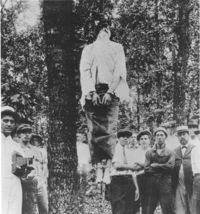 The lynching of Leo Frank |
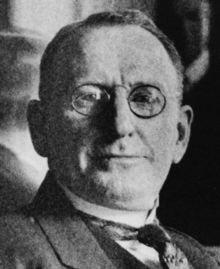 William J. Simmons founded the second Ku Klux Klan in 1915. |
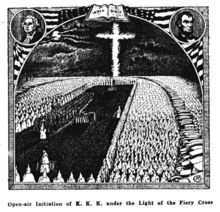 Branford Clarke illustration in The Ku Klux Klan In Prophecy by Bishop Alma White published by the Pillar of Fire Church in 1925 at Zarephath, NJ |
Three events in 1915 acted as catalysts to the revival of the Klan:
- The film The Birth of a Nation was released, mythologizing and glorifying the first Klan.
- Leo Frank was lynched near Atlanta after the Georgia governor commuted his death sentence to life in prison. Frank had been convicted in 1913 and sentenced to death for the rape and murder of a young white factory worker named Mary Phagan, in a trial marked by intimidation of the jury and media frenzy. His legal appeals had been exhausted.
- The second Ku Klux Klan was founded by William J. Simmons at Stone Mountain, outside Atlanta. It added to the original anti-black ideology with a new anti-immigrant, anti-Catholic, prohibitionist and antisemitic agenda. Most of the founders were from an Atlanta-area organization calling itself the Knights of Mary Phagan, which had organized around Leo Frank's trial. The new organization emulated the fictionalized version of the Klan presented in The Birth of a Nation.
The Birth of a Nation
Director D. W. Griffith's The Birth of a Nation glorified the original Klan. His film was based on the book and play The Clansman and the book The Leopard's Spots, both by Thomas Dixon, Jr.. Dixon said his purpose was "to revolutionize northern sentiment by a presentation of history that would transform every man in my audience into a good Democrat!" The film created a nationwide Klan craze. At the official premier in Atlanta, members of the Klan rode up and down the street in front of the theater.[60]
Much of the modern Klan's iconography, including the standardized white costume and the lighted cross, are derived from the film. Its imagery was based on Dixon's romanticized concept of old Scotland, as portrayed in the novels and poetry of Sir Walter Scott. The film's influence and popularity were enhanced by a widely reported endorsement by historian and U.S. President Woodrow Wilson.
The Birth of a Nation included extensive quotations from Woodrow Wilson's History of the American People, as if to give it a stronger basis. After seeing the film in a special White House screening, Wilson allegedly said, "It is like writing history with lightning, and my only regret is that it is all so terribly true."[61] Given Wilson's views on race and the Klan, his statement was taken as supportive of the film. In later correspondence with Griffith, Wilson confirmed his enthusiasm. Wilson's remarks immediately became controversial. Wilson tried to remain aloof, but finally, on April 30, he issued a non-denial denial.[62] The historian Arthur Link quoted comments by Wilson's aide, Joseph Tumulty: "the President was entirely unaware of the nature of the play before it was presented and at no time has expressed his approbation of it."[63]
Leo Frank
Another event that influenced the Klan was sensational coverage in 1913 of the trial, conviction and sentencing of a Jewish factory manager from Atlanta named Leo Frank. In lurid newspaper accounts, Frank was accused of the rape and murder of Mary Phagan, a girl employed at his factory.
After a trial in Georgia in which a mob daily surrounded the courtroom, Frank was convicted. Because of the presence of the armed mob, the judge asked Frank and his counsel to stay away when the verdict was announced. Frank's legal appeals of his trial failed, despite the revelation of new evidence casting doubt on his guilt. US Supreme Court Justice Oliver Wendell Holmes dissented from other justices in their upholding of his conviction and condemned the mob's intimidation of the jury as the court's failing to provide due process to the defendant. After the governor commuted Frank's sentence to life imprisonment in 1915, a mob calling itself the Knights of Mary Phagan kidnapped Frank from prison and lynched him.
The Frank trial was used skillfully by Georgia politician and publisher Thomas E. Watson, the editor for The Jeffersonian magazine. He was a leader in recreating the Klan and was later elected to the U.S. Senate. The new Klan was inaugurated in 1915 at a meeting led by William J. Simmons on top of Stone Mountain. A few aging members of the original Klan attended, along with members of the self-named Knights of Mary Phagan.
Simmons stated that he had been inspired by the original Klan's Prescripts, written in 1867 by Confederate veteran George Gordon in an attempt to create a national organization. These were never adopted by the Klan, however.[64] The Prescript stated the Klan's purposes in idealistic terms, hiding the fact that its members committed acts of vigilante violence and murder from behind masks.
Social factors
The second Klan arose during the nadir of American race relations, in response to urbanization and industrialization. Massive immigration from the largely Catholic countries of eastern and southern Europe led to friction with America's longer-established Protestant citizens. The Great Migration of African Americans to the North stoked racism by whites in Northern industrial cities; thus the second Klan would achieve its greatest political power not in any Southern state, but in Indiana. The migration of African Americans and whites from rural areas to Southern cities further increased tensions. The Klan grew most rapidly in urbanizing cities which had high growth rates between 1910 and 1930, such as Detroit, Memphis, Dayton, Atlanta, Dallas, and Houston. In Michigan, more than half of the members lived in Detroit and were concerned about urban issues: limited housing, rapid social change, competition for jobs.[65] Stanley Horn, a Southern historian sympathetic to the first Klan, was careful in an oral interview to distinguish it from the later "spurious Ku Klux organization which was in ill-repute—and, of course, had no connection whatsoever with the Klan of Reconstruction days".[66]
In an era without Social Security or widely available life insurance, it was common for men to join fraternal organizations such as the Elks or the Woodmen of the World to provide for their families in case they died or were unable to work. The founder of the new Klan, William J. Simmons, was a member of twelve different fraternal organizations. He recruited for the Klan with his chest covered with fraternal badges, and consciously modeled the Klan after those organizations.[67]
Klan organizers, called "Kleagles", signed up hundreds of new members, who paid initiation fees and bought KKK costumes. The organizer kept half the money and sent the rest to state or national officials. When the organizer was done with an area, he organized a huge rally, often with burning crosses and perhaps presented a Bible to a local Protestant minister. He then left town with the money. The local units operated like many fraternal organizations and occasionally brought in speakers.
The Klan's growth was also affected by mobilization for World War I and postwar tensions, especially in the cities where strangers came up against each other more often. Southern whites resented the arming of black soldiers. Black veterans did not want to go back to second-class status in the United States. Some were lynched, still in uniform, upon returning from overseas service.[68]
Activities
In reaction to social changes, the Klan adopted anti-Jewish, anti-Catholic, anti-Communist and anti-immigrant slants.
Although Klan members were concentrated in the South, Midwest and west, there were some members in New England, too. Klan members torched an African American school in Scituate, Rhode Island.[69]
Temperance
Lender et al. state that the Klan's resurgence in the 1920s was aided by the temperance movement. In Arkansas and elsewhere, the Klan opposed bootleggers, and in 1922, two hundred Klan members set fire to saloons in Union County. The national Klan office was finally established in Dallas, Texas, but Little Rock, Arkansas was the home of the Women of the Ku Klux Klan. The first head of this auxiliary was a former president of the Arkansas WCTU.[70] One historian contends that the KKK's "support for Prohibition represented the single most important bond between Klansmen throughout the nation".[71] Membership in the Klan and other prohibition groups overlapped, and they often coordinated activities. For example, Edward Young Clarke, a top leader of the Klan, raised funds for both the Klan and the Anti-Saloon League.[72] Clarke was indicted in 1923 for violations of the Mann Act.[73]
Labor and anti-unionism
The social unrest of the postwar period included labor strikes in response to low wages and poor working conditions in many industrial cities, often led by immigrants, who also organized unions. Klan members worried about labor organizers' effect on their jobs, as well as the socialist leanings of some of the immigrants, which only added to the tensions. They also resented upwardly mobile ethnic Catholics.[74] At the same time, in cities Klan members were themselves working in industrial environments and often struggled with working conditions.
In southern cities such as Birmingham, Alabama, Klan members kept control of access to the better-paying industrial jobs but opposed unions. During the 1930s and 1940s, Klan leaders urged members to disrupt the Congress of Industrial Organizations (CIO), which advocated industrial unions and was open to African-American members. With access to dynamite and skills from their jobs in mining and steel, in the late 1940s some Klan members in Birmingham began using bombings to intimidate upwardly mobile blacks who moved into middle-class neighborhoods. "By mid-1949, there were so many charred house carcasses that the area [College Hills] was informally named Dynamite Hill." Independent Klan groups remained active in Birmingham and were deeply engaged in violent opposition to the Civil Rights Movement.[75]
Urbanization

A significant characteristic of the second Klan was that it was an organization based in urban areas, reflecting the major shifts of population to cities in both the North and the South. In Michigan, for instance, 40,000 members lived in Detroit, where they made up more than half of the state's membership. Most Klansmen were lower- to middle-class whites who were trying to protect their jobs and housing from the waves of newcomers to the industrial cities: immigrants from southern and eastern Europe, who tended to be Catholic and Jewish in numbers higher than earlier groups of immigrants; and black and white migrants from the South. As new populations poured into cities, rapidly changing neighborhoods created social tensions. Because of the rapid pace of population growth in industrializing cities such as Detroit and Chicago, the Klan grew rapidly in the U.S. Midwest. The Klan also grew in booming Southern cities such as Dallas and Houston.[76]
In the medium-size industrial city of Worcester, Massachusetts in the 1920s, the Klan ascended to power quickly but diminished as a result of opposition from the Catholic Church. There was no violence and the local newspaper ridiculed Klansmen as "night-shirt knights". Half of the members were Swedish American, including some first-generation immigrants. The ethnic and religious conflicts between Worcester residents is discussed. Swedish Protestants fought against Irish Catholics for political and ideological control of the city.[77]
For some states, historians have obtained membership rosters of some local units and matched the names against city directory and local records to create statistical profiles of the membership. Big city newspapers were often hostile and ridiculed Klansmen as ignorant farmers. Detailed analysis from Indiana showed the rural stereotype was false for that state:
Indiana's Klansmen represented a wide cross section of society: they were not disproportionately urban or rural, nor were they significantly more or less likely than other members of society to be from the working class, middle class, or professional ranks. Klansmen were Protestants, of course, but they cannot be described exclusively or even predominantly as fundamentalists. In reality, their religious affiliations mirrored the whole of white Protestant society, including those who did not belong to any church.[78]
The Klan attracted people but most of them did not remain in the organization for long. Membership in the Klan turned over rapidly as people found out that it was not the group they wanted. Millions joined, and at its peak in the 1920s, the organization included about 15% of the nation's eligible population. The lessening of social tensions contributed to the Klan's decline.
The burning cross
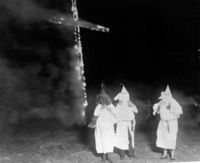
The second Klan adopted a burning Latin cross as its symbol. No such crosses had been used by the first Klan, but the burning cross became a symbol of intimidation by the second Klan.[79]
The practice of cross burning had been loosely based on ancient Scottish clans' burning a St. Andrew's cross (an X-shaped cross) as a beacon to muster forces for war. In The Clansman (see above), Dixon had falsely claimed that the first Klan had used fiery crosses when rallying to fight against Reconstruction. Griffith brought this image to the screen in The Birth of a Nation; he mistakenly portrayed the burning cross as an upright Latin cross rather than the St. Andrew's cross. Simmons adopted the symbol wholesale from the movie, prominently displaying it at the 1915 Stone Mountain meeting. The symbol has been associated with the Klan ever since.[80]
Political influence
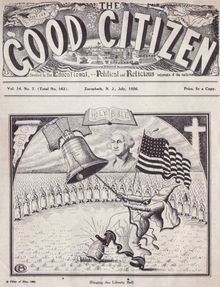
The Klan had major political influence in several states, and it was influential mostly in the center of the country. The Klan spread from the South into the Midwest and Northern states. It also arose in Canada, where there was a large movement against Catholic immigrants.[81] At its peak, Klan membership exceeded four million and comprised 20% of the adult white male population in many broad geographic regions, and 40% in some areas. Most of the Klan's membership resided in Midwestern states.
In another well-known example from the same year, the Klan decided to turn Anaheim, California, into a model Klan city. It secretly took over the City Council. When the members' affiliation became known, the city conducted a special recall election, and citizens voted out the Klan members.[82]
The Klan issue played a significant role at the bitterly divisive 1924 Democratic National Convention in New York City. The leading candidates were Protestant William Gibbs McAdoo, with a base in areas where the Klan was strong, and Catholic New York Governor Al Smith, with a base in the large cities. After weeks of stalemate, both candidates withdrew in favor of a compromise. Anti-Klan delegates proposed a resolution indirectly attacking the Klan; it was narrowly defeated.[83][84]
In some states, such as Alabama, members of the KKK worked for political and social reform. The state's Klansmen were among the foremost advocates of better public schools, effective prohibition enforcement, expanded road construction, and other political measures which benefited lower-class white people. By 1925, the Klan was a political force in the state, as leaders such as J. Thomas Heflin, David Bibb Graves, and Hugo Black manipulated the KKK membership to try to build political power against the Black Belt planters, who had long dominated the state.[85] Black was elected US senator in 1926; President Franklin D. Roosevelt appointed Black to the Supreme Court not knowing he had been active in the Klan in the 1920s. In 1926, with Klan support, Bibb Graves won the Alabama governor's office. He was a former Klan chapter head. He pushed for increased education funding, better public health, new highway construction, and pro-labor legislation. Because the Alabama state legislature refused to redistrict until 1972, however, even the Klan was unable to break the planters' and rural areas' hold on legislative power.
Its predecessor had been an exclusively partisan Democratic organization in the South. The second Klan grew in the Midwest, where for a time, its members were courted by both Republicans and Democrats. The KKK state organizations endorsed candidates from either party that supported its goals; Prohibition in particular helped the Klan and some Republicans to make common cause in the Midwest. In the South, however, the southern Klan remained Democratic, closely allied with Democratic police, sheriffs, and other functionaries of local government. With continuing disfranchisement of most African Americans and many poor whites, the only political activity took place within the Democratic Party.
Resistance and decline
The Ku Klux Klan rose to prominence in Indiana politics and society after World War I. It was made up of native-born, white Protestants of many income and social levels. Nationally, in the 1920s, Indiana had the most powerful Ku Klux Klan. Though it counted a high number of members statewide, (over 30% of its white male citizens[86]) its importance peaked with the 1924 election of Edward Jackson for governor. A short time later, the scandal surrounding the murder trial of D.C. Stephenson destroyed the image of the Ku Klux Klan as upholders of law and order. By 1926 the Ku Klux Klan was "crippled and discredited." [87]

D. C. Stephenson was the Grand Dragon of Indiana and 22 northern states. He led the states under his control to separate from the national KKK organization in 1923. In his 1925 trial, he was convicted for second degree murder for his part in the rape and subsequent death [88] of Madge Oberholtzer. After Stephenson's conviction in a sensational trial, the Klan declined dramatically in Indiana. Historian Leonard Moore concluded that a failure in leadership caused the Klan's collapse:
Stephenson and the other salesmen and office seekers who maneuvered for control of Indiana's Invisible Empire lacked both the ability and the desire to use the political system to carry out the Klan's stated goals. They were uninterested in, or perhaps even unaware of, grass roots concerns within the movement. For them, the Klan had been nothing more than a means for gaining wealth and power. These marginal men had risen to the top of the hooded order because, until it became a political force, the Klan had never required strong, dedicated leadership. More established and experienced politicians who endorsed the Klan, or who pursued some of the interests of their Klan constituents, also accomplished little. Factionalism created one barrier, but many politicians had supported the Klan simply out of expedience. When charges of crime and corruption began to taint the movement, those concerned about their political futures had even less reason to work on the Klan's behalf.:[89]
Many groups and leaders, including prominent Protestant ministers such as Reinhold Niebuhr in Detroit, spoke out against the Klan. In response to blunt attacks against Jewish Americans and the Klan's campaign to outlaw private schools, the Jewish Anti-Defamation League was formed after the lynching of Leo Frank. When one civic group began to publish Klan membership lists, the number of members quickly declined. The National Association for the Advancement of Colored People carried on public education campaigns in order to inform people about Klan activities and lobbied against Klan abuses in Congress. After its peak in 1925, Klan membership in most areas of the Midwest began to decline rapidly.[76]
In Alabama, KKK vigilantes, thinking that they had governmental protection, launched a wave of physical terror in 1927. They targeted both blacks and whites for violation of racial norms and for perceived moral lapses.[90] This led however to a large backlash beginning in the media. Grover C. Hall, Sr., editor of the Montgomery Advertiser, began publishing a series of editorials and articles that attacked the Klan for its "racial and religious intolerance". Hall won a Pulitzer Prize for his crusade.[91] Other newspapers kept up a steady, loud attack on the Klan, referring to the organization as violent and "un-American". Sheriffs cracked down. In the 1928 presidential election, the state voted for the Democratic candidate Al Smith, although he was Catholic.
Klan membership in Alabama dropped to less than six thousand by 1930. Small independent units continued to be active in Birmingham, where in the late 1940s, members launched a reign of terror by bombing the homes of upwardly mobile African Americans. Activism by such independent KKK groups increased as a reaction against the Civil Rights Movement of the 1950s and 1960s.
Imperial Wizard Hiram Wesley Evans sold the organization in 1939 to James Colescott, an Indiana veterinarian, and Samuel Green, an Atlanta obstetrician. They were unable to staunch the declining membership. In 1944, the IRS filed a lien for $685,000 in back taxes against the Klan, and Colescott was forced to dissolve the organization in 1944. Local Klan groups closed over the following years.[92]
Due in part to the Klan terror directed at them, five million blacks left the South for northern, midwestern and western cities from 1940 to 1970.
After World War II, folklorist and author Stetson Kennedy infiltrated the Klan and provided information to media and law enforcement agencies. He also provided secret code words to the writers of the Superman radio program, resulting in episodes in which Superman took on the KKK. Kennedy's intention to strip away the Klan's mystique and trivialize the Klan's rituals and code words may have contributed to the decline in Klan recruiting and membership.[93] In the 1950s, Kennedy wrote a bestselling book about his experiences, which further damaged the Klan.[94]
The following table shows the change in the Klan's estimated membership over time.[95] (The years given in the table represent approximate time periods.)
| Year | Membership |
|---|---|
| 1920 | 4,000,000[96] |
| 1924 | 6,000,000 |
| 1930 | 30,000 |
| 1980 | 5,000 |
| 2008 | 6,000 |
Later Klans, 1950 through 1960s
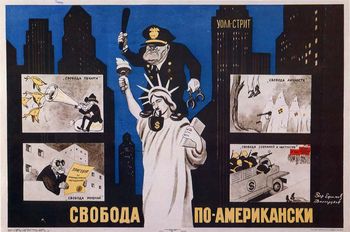
The name "Ku Klux Klan" began to be used by several independent groups. Beginning in the 1950s, for instance, individual Klan groups in Birmingham, Alabama began to resist social change and blacks' improving their lives by bombing houses in transitional neighborhoods. There were so many bombings in Birmingham of blacks' homes by Klan groups in the 1950s that the city's nickname was "Bombingham".[11]
During the tenure of Bull Connor as police commissioner in the city, Klan groups were closely allied with the police and operated with impunity. When the Freedom Riders arrived in Birmingham, Connor gave Klan members fifteen minutes to attack the riders before sending in the police to quell the attack.[11] When local and state authorities failed to protect the Freedom Riders and activists, the federal government established effective intervention.
In states such as Alabama and Mississippi, Klan members forged alliances with governors' administrations.[11] In Birmingham and elsewhere, the KKK groups bombed the houses of civil rights activists. In some cases they used physical violence, intimidation and assassination directly against individuals. Many murders went unreported and were not prosecuted by local and state authorities. Continuing disfranchisement of blacks across the South meant that most could not serve on juries, which were all white.
According to a report from the Southern Regional Council in Atlanta, the homes of 40 black Southern families were bombed during 1951 and 1952. Some of the bombing victims were social activists whose work exposed them to danger, but most were either people who refused to bow to racist convention or were innocent bystanders, unsuspecting victims of random violence.[97]
Among the more notorious murders by Klan members:
- The 1951 Christmas Eve bombing of the home of NAACP activists Harry and Harriette Moore in Mims, Florida, resulting in their deaths.[98]
- The 1957 murder of Willie Edwards, Jr. Klansmen forced Edwards to jump to his death from a bridge into the Alabama River.[99]
- The 1963 assassination of NAACP organizer Medgar Evers in Mississippi. In 1994, former Ku Klux Klansman Byron De La Beckwith was convicted.
- The 1963 bombing of the 16th Street Baptist Church in Birmingham, Alabama, which killed four African-American girls. The perpetrators were Klan members Robert Chambliss, convicted in 1977, Thomas Blanton and Bobby Frank Cherry, convicted in 2001 and 2002. The fourth suspect, Herman Cash, died before he was indicted.
- The 1964 murders of three civil rights workers Chaney, Goodman, and Schwerner in Mississippi. In June 2005, Klan member Edgar Ray Killen was convicted of manslaughter.[100]
- The 1964 murder of two black teenagers, Henry Hezekiah Dee and Charles Eddie Moore in Mississippi. In August 2007, based on the confession of Klansman Charles Marcus Edwards, James Ford Seale, a reputed Ku Klux Klansman, was convicted. Seale was sentenced to serve three life sentences. Seale was a former Mississippi policeman and sheriff's deputy.[101]
- The 1965 Alabama murder of Viola Liuzzo. She was a Southern-raised Detroit mother of five who was visiting the state in order to attend a civil rights march. At the time of her murder Liuzzo was transporting Civil Rights Marchers.
- The 1966 firebombing death of NAACP leader Vernon Dahmer Sr., 58, in Mississippi. In 1998 former Ku Klux Klan wizard Sam Bowers was convicted of his murder and sentenced to life. Two other Klan members were indicted with Bowers, but one died before trial, and the other's indictment was dismissed.
There was also resistance to the Klan. In 1953, newspaper publisher W. Horace Carter received a Pulitzer prize for reporting on the activities of the Klan. In a 1958 North Carolina incident, the Klan burned crosses at the homes of two Lumbee Native Americans who had associated with white people, and they threatened to return with more men. When the KKK held a nighttime rally nearby, they were quickly surrounded by hundreds of armed Lumbees. Gunfire was exchanged, and the Klan was routed at what became known as the Battle of Hayes Pond.[102]
While the FBI had paid informants in the Klan, for instance in Birmingham in the early 1960s, its relations with local law enforcement agencies and the Klan were often ambiguous. The head of the FBI J. Edgar Hoover, appeared more concerned about Communist links to civil rights activists than about controlling Klan excesses against citizens. In 1964, the FBI's COINTELPRO program began attempts to infiltrate and disrupt civil rights groups.[11]
As 20th-century Supreme Court rulings extended federal enforcement of citizens' civil rights, the government revived the Force Act and Klan Act from Reconstruction days. Federal prosecutors used these laws as the basis for investigations and indictments in the 1964 murders of Chaney, Goodman, and Schwerner;[103] and the 1965 murder of Viola Liuzzo.[104] They were also the basis for prosecution in 1991 in Bray v. Alexandria Women's Health Clinic.
Contemporary Klan: 1970s–present

Once African Americans secured federal legislation to protect civil and voting rights, the KKK shifted its focus to opposing court-ordered busing to desegregate schools, affirmative action and more open immigration. In 1971, KKK members used bombs to destroy 10 school buses in Pontiac, Michigan.
Altercation with Communist Workers Party
On November 3, 1979, five protesters were killed by KKK and American Nazi Party members in the Greensboro massacre in Greensboro, North Carolina.[105] This incident was the culmination of attempts by the Communist Workers Party to organize industrial workers, predominantly black, in the area.[106]
Jerry Thompson infiltration
Jerry Thompson, a newspaper reporter who infiltrated the KKK in 1979, reported that the FBI's COINTELPRO efforts were highly successful. Rival KKK factions accused each other's leaders of being FBI informants. Bill Wilkinson of the Invisible Empire, Knights of the Ku Klux Klan, was revealed to have been working for the FBI.[107]
Thompson, the journalist who claimed he had infiltrated the Klan, related that KKK leaders who appeared indifferent to the threat of arrest showed great concern about a series of civil lawsuits filed by the Southern Poverty Law Center for damages of millions of dollars. These were filed after KKK members shot into a group of African Americans. Klansmen curtailed activities to conserve money for defense against the lawsuits. The KKK also used lawsuits as tools; they filed a libel suit to prevent publication of a paperback edition of Thompson's book.
Tennessee shooting
In 1980, three KKK members shot four elderly black women (Viola Ellison, Lela Evans, Opal Jackson and Katherine Johnson) in Chattanooga, Tennessee, following a KKK initiation rally. A fifth woman, Fannie Crumsey, was injured by flying glass in the incident. Attempted murder charges were filed against the three KKK members, two of whom—Bill Church and Larry Payne—were acquitted by an all-white jury, and the other of whom—Marshall Thrash—was sentenced by the same jury to nine months on lesser charges. He was released after three months.[108][109][110] In 1982, a jury awarded the five women $535,000 in a civil rights trial.[111]
Michael Donald lynching
After Michael Donald was lynched in 1981 in Alabama, the FBI investigated his death and two local KKK members were convicted of having a role, including Henry Hayes, who was sentenced to death. With the support of attorneys Morris Dees and Joseph J. Levin of the Southern Poverty Law Center (SPLC), Donald's mother, Beulah Mae Donald, sued the KKK in civil court in Alabama. Her lawsuit against the United Klans of America was tried in February 1987. The all-white jury found the Klan responsible for the lynching of Donald and ordered the Klan to pay US$7 million. To pay the judgment, the KKK turned over all of its assets, including its national headquarters building in Tuscaloosa.[112] After exhausting the appeals process, Hayes was executed for Donald's death in Alabama on June 6, 1997. It was the first time since 1913 that a white man had been executed in Alabama for a crime against an African American.[113]
Neo-Nazi alliances and Stormfront
In 1995, Don Black and Chloê Hardin, former KKK Grand Wizard David Duke's ex-wife, began a small bulletin board system (BBS) called Stormfront. Today, Stormfront has become a prominent online forum for white nationalism, Neo-Nazism, hate speech, racism, and antisemitism.[114][115][116] Duke has an account on Stormfront which he uses to post articles from his own website, as well as polling forum members for opinions and questions, in particular during his internet broadcasts. Duke has worked with Don Black on numerous projects including Operation Red Dog in 1980.[117][118]
Modern statistics
The modern KKK is not one organization; rather it is composed of small independent chapters across the US.[119] The formation of independent chapters has made KKK groups more difficult to infiltrate, and researchers find it hard to estimate their numbers. Estimates are that about two-thirds of KKK members are concentrated in the Southern United States, with another third situated primarily in the lower Midwest.[120][121][122] KKK members have stepped up recruitment in recent years, but the organization grows slowly, with membership estimated at 5,000–8,000 across 179 chapters. These recent membership campaigns have been based on issues such as people's anxieties about illegal immigration, urban crime and same-sex marriage.[123] Many KKK groups have formed strong alliances with other white supremacist groups, such as neo-Nazis. Some KKK groups have become increasingly "Nazified", adopting the look and emblems of white power skinheads.[124]
On November 14, 2008, an all-white jury of seven men and seven women awarded $1.5 million in compensatory damages and $1 million in punitive damages to plaintiff Jordan Gruver, represented by the Southern Poverty Law Center against the Imperial Klans of America.[125] The ruling found that five IKA members had savagely beaten Gruver, then 16 years old, at a Kentucky county fair in July 2006.[126]
The American Civil Liberties Union (ACLU) has provided legal support to various factions of the KKK in defense of their First Amendment rights to hold public rallies, parades, and marches, as well as their right to field political candidates.[127]
Current Klan splinter divisions have grown substantially since the 2008 election of U.S. President Barack Obama, the first African-American to hold the office;[128][129] the Klan has expanded its recruitment efforts to white supremacists at the international level.[130] Current membership estimates by the ADL hold at a national estimate of five thousand.[122]
Ex-Grand Wizard David Duke has claimed that thousands of Tea Party movement activists have urged him to run for president in 2012 [131] and he is seriously considering entering the Republican Party primaries.[132] Duke has also released a video detailing his platform.[133] In the video pledges that as president he would stop all immigration to the US, including legal immigration, and says that he "will not let Israel or any nation dictate our foreign policy."[134] He has also claimed that he would be "willing to risk life and limb, endure the barbs of the media" to mount "the most honest campaign for president since the time of our Founding Fathers." [135]
Current Klan organizations
- Bayou Knights of the Ku Klux Klan, prevalent in Texas, Oklahoma, Arkansas, Louisiana and other areas of the Southeastern U.S.
- Church of the American Knights of the Ku Klux Klan[120]
- Imperial Klans of America[136]
- Knights of the White Camelia[137]
- Knights of the Ku Klux Klan, headed by national director and self-claimed pastor Thom Robb, and based in Zinc, Arkansas.[138] It claims to be the biggest Klan organization in America today. Spokesmen refer to it as a "sixth era Klan", and it continues to be a racist group.
Vocabulary
Membership in the Klan is secret. Like many fraternal organizations, the Klan has signs which members can use to recognize one another. A member may use the acronym AYAK (Are you a Klansman?) in conversation to surreptitiously identify himself to another potential member. The response AKIA (A Klansman I am) completes the greeting.[139]
Throughout its varied history, the Klan has coined many words[140] beginning with "KL" including:
- Klabee: treasurers
- Klavern: local organization
- Kleagle: recruiter
- Klecktoken: initiation fee
- Kligrapp: secretary
- Klonvocation: gathering
- Kloran: ritual book
- Kloreroe: delegate
- Kludd: chaplain
All of the above terminology was created by William Simmons, as part of his 1915 revival of the Klan.[141] The Reconstruction-era Klan used different titles; the only titles to carry over were "Wizard" for the overall leader of the Klan, "Night Hawk" for the official in charge of security, and a few others, mostly for regional officers of the organization.
This article is copied from an article on Wikipedia® - the free encyclopedia created and edited by online user community. The text was not checked or edited by anyone on our staff. Although the vast majority of the Wikipedia® encyclopedia articles provide accurate and timely information please do not assume the accuracy of any particular article. This article is distributed under the terms of GNU Free Documentation License.
Thanks to Encyclopedia The Free Dictionary / Farlex, Inc.
http://encyclopedia.thefreedictionary.com/p/Ku%20Klux%20Klan
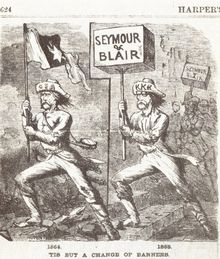


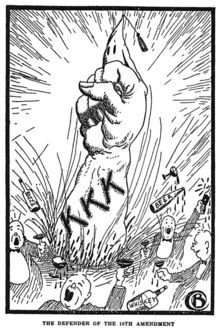
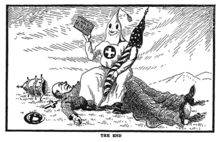



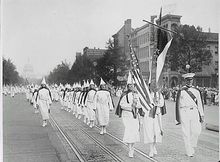
No comments:
Post a Comment